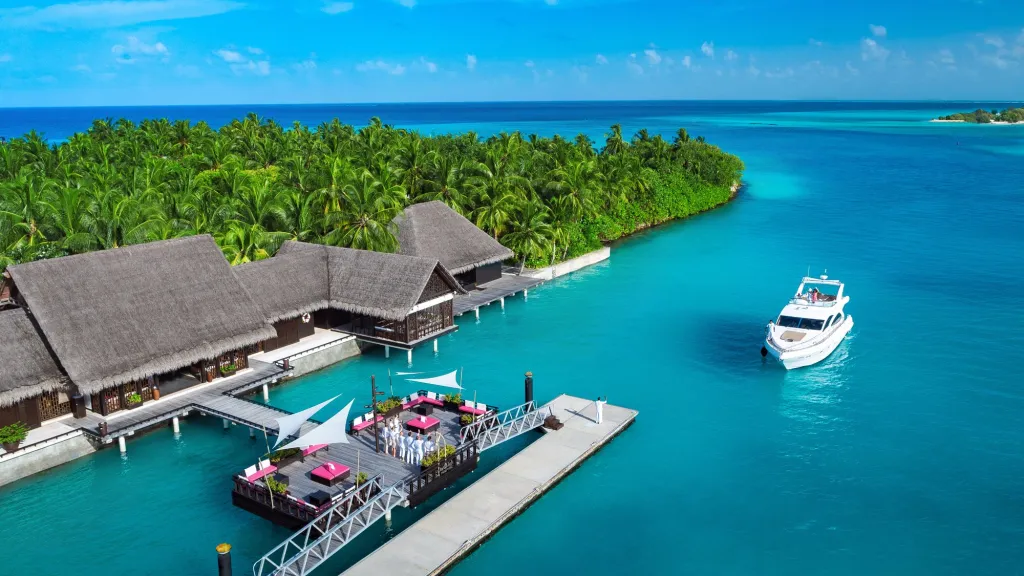Ah, **Lakshadweep**! What a fascinating archipelago! It's like a hidden gem tucked away in the azure waters of the Laccadive Sea. Let me tell you a bit more about this enchanting place.
- **Location and Geography**:
- Lakshadweep, formerly known as the Laccadives, is a group of islands situated 200–440 km (120–270 mi) off India's west coast in the Arabian Sea. These islands are India's only coral atolls and are geologically part of the same chain as the Maldives¹—so you can imagine the stunning marine life and crystal-clear waters!
- The archipelago consists of 36 islands, divided into three subgroups: the Amindivi Islands in the north, separated from the Laccadive Islands by the 11th parallel north, and the atoll of Minicoy to the south along the 9th parallel north.
- **Population and Culture**:
- Approximately 64,473 people call Lakshadweep home, spread across ten inhabited islands. These islands have a rich cultural heritage, influenced by various historical periods.
- Archaeological evidence suggests human settlement in the region dating back to at least 1500 BC. The islands have been mentioned in Buddhist Jataka tales from the 3rd century BC.
- Over time, Lakshadweep has been part of different kingdoms—the Cheras, Pallavas, Cholas, and even the Portuguese. Islam arrived in the later half of the 7th century AD.
- **Natural Beauty and Biodiversity**:
- Imagine pristine beaches, coconut groves, and vibrant coral reefs. Lakshadweep offers all that and more.
- The islands are the northernmost part of the Chagos-Lakshadweep Ridge, an undersea mountain range. So, beneath the waves, there's a whole world waiting to be explored.
- **Fun Fact**:
- The name "Lakshadweep" means "a hundred thousand islands" in Malayalam. While there aren't quite that many islands, the name reflects the archipelago's allure and mystique.
If you ever get a chance to visit, don't miss out on the turquoise lagoons, vibrant marine life, and the warm hospitality of the locals.
- **Location and Geography**:
- Lakshadweep, formerly known as the Laccadives, is a group of islands situated 200–440 km (120–270 mi) off India's west coast in the Arabian Sea. These islands are India's only coral atolls and are geologically part of the same chain as the Maldives¹—so you can imagine the stunning marine life and crystal-clear waters!
- The archipelago consists of 36 islands, divided into three subgroups: the Amindivi Islands in the north, separated from the Laccadive Islands by the 11th parallel north, and the atoll of Minicoy to the south along the 9th parallel north.
- **Population and Culture**:
- Approximately 64,473 people call Lakshadweep home, spread across ten inhabited islands. These islands have a rich cultural heritage, influenced by various historical periods.
- Archaeological evidence suggests human settlement in the region dating back to at least 1500 BC. The islands have been mentioned in Buddhist Jataka tales from the 3rd century BC.
- Over time, Lakshadweep has been part of different kingdoms—the Cheras, Pallavas, Cholas, and even the Portuguese. Islam arrived in the later half of the 7th century AD.
- **Natural Beauty and Biodiversity**:
- Imagine pristine beaches, coconut groves, and vibrant coral reefs. Lakshadweep offers all that and more.
- The islands are the northernmost part of the Chagos-Lakshadweep Ridge, an undersea mountain range. So, beneath the waves, there's a whole world waiting to be explored.
- **Fun Fact**:
- The name "Lakshadweep" means "a hundred thousand islands" in Malayalam. While there aren't quite that many islands, the name reflects the archipelago's allure and mystique.
If you ever get a chance to visit, don't miss out on the turquoise lagoons, vibrant marine life, and the warm hospitality of the locals.
Ah, **Lakshadweep**! What a fascinating archipelago! 🏝️ It's like a hidden gem tucked away in the azure waters of the Laccadive Sea. Let me tell you a bit more about this enchanting place.
- **Location and Geography**:
- Lakshadweep, formerly known as the Laccadives, is a group of islands situated 200–440 km (120–270 mi) off India's west coast in the Arabian Sea. These islands are India's only coral atolls and are geologically part of the same chain as the Maldives¹—so you can imagine the stunning marine life and crystal-clear waters!
- The archipelago consists of 36 islands, divided into three subgroups: the Amindivi Islands in the north, separated from the Laccadive Islands by the 11th parallel north, and the atoll of Minicoy to the south along the 9th parallel north.
- **Population and Culture**:
- Approximately 64,473 people call Lakshadweep home, spread across ten inhabited islands. These islands have a rich cultural heritage, influenced by various historical periods.
- Archaeological evidence suggests human settlement in the region dating back to at least 1500 BC. The islands have been mentioned in Buddhist Jataka tales from the 3rd century BC.
- Over time, Lakshadweep has been part of different kingdoms—the Cheras, Pallavas, Cholas, and even the Portuguese. Islam arrived in the later half of the 7th century AD.
- **Natural Beauty and Biodiversity**:
- Imagine pristine beaches, coconut groves, and vibrant coral reefs. Lakshadweep offers all that and more. 🌴
- The islands are the northernmost part of the Chagos-Lakshadweep Ridge, an undersea mountain range. So, beneath the waves, there's a whole world waiting to be explored.
- **Fun Fact**:
- The name "Lakshadweep" means "a hundred thousand islands" in Malayalam. While there aren't quite that many islands, the name reflects the archipelago's allure and mystique.
If you ever get a chance to visit, don't miss out on the turquoise lagoons, vibrant marine life, and the warm hospitality of the locals. 🌊✨





